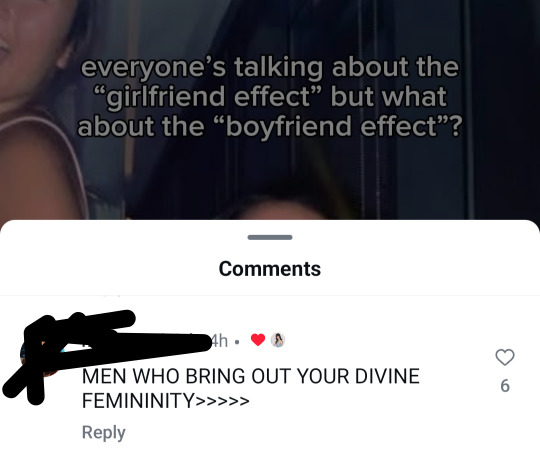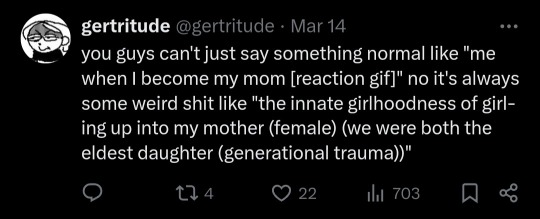#also--- divine femininity??????
Explore tagged Tumblr posts
Text


#boink#oh instagram reels#btw in this video she had a “glow up”#which was basically having aged a little#like regular young adulthood early 20s type you're not gonna look the same as time goes on#like she got bangs and new glasses#i didnt even notice the first two times the video looped#like what#like cool!#yeah!#having a partner who loves and supports you will probably make you look happier! since you feel happier! ok!#also everyone looks different after a year when they're like twenty one!#what!#that's not the boyfriend effect that's just! being human! what the fuck!#also--- divine femininity??????#oh brother#for pete's sake#if you will#look for the most part i think that in general the women and girls and ppl that go with this kind of thing#the divine femininity and girl math and girl pretty and boy pretty etc etc etc#like i hate this kind of stuff but im not about to say that theyre at fault for it#like this is not helping anyone#and it just#god#it makes me upset!#maybe im overreacting but also i kind of think that we're collectively underreacting about this#like i dont wanna see it all over tiktok /let alone/ from my actual real life friends!#earlier this year my friends (women! women friends! staunchly feminist friends!) were joking unironically about girl math#like do we not see how that's harmful. when we talk about poor financial decisions and completely seriously call it girl math.#how do we not see a problem here
92 notes
·
View notes
Text


thirst trap cuz i feel really hot :3
#i gained ten pounds and it’s made me look so much better tbh#also sub to my OF ect..#transgender#trans#it me!#mtf trans#trans mtf#trans femme#transfem#trans feminine#girlslikeus#transisbeautiful#transisbetter#trans is sexy#trans is so hot#this is what trans looks like#trans is divine#trans model#trans goddess#trans girl#trans woman#trans girls#transgirl#transgirls
1K notes
·
View notes
Text
Hmmm just gonna spit this headcanon out in text post form since A. I don't think I could exposit it well enough in image form and B. It's not actually textually/thematically substantiated and I don't like actually staking my stuff on just vibes alone*
But anyway. I'd say it's pretty evident that all the islanders forgot their names, right? King obviously. Because why the hell else would he do that, but also Siffrin No Middle Names No Last Name.
They're 'pretty sure' they've 'always' been 'Just Siffrin' 'as long as they can remember'. It's a pretty cruel twist of the knife to say that they don't even get to keep their birth name as a memento, which is why I'm saying as such.
My utterly unsubstantiated claim is I think it'd be cute to say that Sisyphus *is* the name Siffrin initially picked, assuming the myth of King Sisyphus is recontextualised as idk, just a play or something in the setting. But I like the idea of Siffrin going 'oh shit 🫵 he's just like me fr' at a tortured fictional character long before the irony kicks in.
As for how Sisyphus -> Siffrin. I think that chronic mumbler and emotional doormat Sif just did not correct people who misheard the name during their time travelling, and went through enough places with incompatible phonologies (pronounceable sounds in the language) without ever really writing it down that it just got kinda. Changed until it was unrecognisable, and Siffrin just went with it until the earlier pronunciations slipped out of their swiss-cheese brain. And they just kinda don't remember any of that.
Also, something something the horrid realisation that Siffrin also named themselves after a King. Just not as blatantly.
*(though I think there's something here about Siffrin, a guy from a belief system that seems to thoroughly disincentivise autonomy and self-motivated choice continuously having their hand forced to make changes/choices they don't want but have no choice but to... It's not solid enough to really back this up tbh, but it informs it.)
Anyway.

#theres also something one of my french-speaker friends said about siffrin's official pronounciation being the feminine way to pronounce -in?#which i dont know enough about to really corroborate and theyre busyyyy and havent started the game yet so i cant really ask#im sure someone else has already voiced this easy-to-come-up-with headcanon anyway but just in case nobody has i decided to post it#isat#isat spoilers#in stars and time#isat siffrin#isat loop#i also personally picture sif (and loop especially) being more hostile to the concept of changing themselves after The Encounter#both of them being big grudge-holders and that 'want' to control your own destiny being clearly against how they interpret the universe#as for whether they should be so hostile? probably not! but they appear to be anxious in fear of some kind of divine retribution should#they like. ever even dare to Want. and uh. well. that certainly went well for Loop. not sure they'd be gung-ho to do it again#so Loop being able to go 'oh well it wasn't my REAL name' as a salve for having to make a new identity AGAIN....#while sif is explicitly clinging to it as an anchor for Who They Are If Nothing Else.. they can upset each other and also mirabelle i think#lucabytetalks
804 notes
·
View notes
Text

Tweeted this months ago but this is the sort of attitude I take every time I have to see people talk about some mythical feminine girlhood or something similar
#there's nothing wrong with being feminine but many peoples who say stuff like this seem to think all women are feminine#or have some shared growing up experiences that are also feminine. divine. Sacred. etc weird AF
296 notes
·
View notes
Text
some people open their mouths and I hear the jaws theme tune
#and also an internal “fuck offffff” x ∞#girlblogger#lana del rey#femcel#coquette#lana del rey aesthetic#coquette dollete#coquette girl#dollete aesthetic#female manipulator#lana del ray aka lizzy grant#lizzy grant#hole band#girlblogging#hole#90s vibes#90s#90s aesthetic#hyper femme#female rage#the female gaze#femme fatale#hyper feminine#female hysteria#divine feminine#cinnamon girl#this is what makes us girls#this is a girlblog#hell is a teenage girl
76 notes
·
View notes
Text
crap i used to get a lot more likes now my posts look sad...
1k followers wake tf up!!!!!

#i know im dumb but shouldnt i get 1k likes on everything#/hj but also /srs#girlhood#female hysteria#this is what makes us girls#girl interrupted#hell is a teenage girl#just girly things#girly tumblr#just girly thoughts#girly blog#female manipulator#im just a girl#coquette dollete#coquette core#coquette girl#dollette#girl manipulator#manic pixie nightmare#manic pixie dream girl#femcel#divine feminine#lana del ray aesthetic#lizzy grant#elizabeth woolridge grant#lizzy grant aesthetic#lana del ray aka lizzy grant#lana del rey#female rage#dolletecore
28 notes
·
View notes
Text





some day soon some day soon
#also a stp/doors lyric loool i ♡ that album smmm fw it heavy fr#the caption i mean#hell is a teenage girl#locally hated#sparkle jump rope queen#gaslight gatekeep girlboss#just girly thoughts#this is a girlblog#sillyposting#just girly things#goth#girlblogger#femcel#dollette#whisper girl#lana del rey#im just a girl#girl interrupted#baby doll#coquette dollete#female hysteria#girlblogging#girlhood#angel#fawn angel#girl hysteria#divine feminine#fawncore#lana del rey unreleased#lana del ray aka lizzy grant
34 notes
·
View notes
Note
hi I love your tags so so much! they were so sweet and so interesting and creative and the whole Aphrodite type of beauty thing sounds really interesting do you have any articles and recommendations to read further into it??
-hogoflight
Hello my fine feathered (I am assuming possession of feathers if you are, indeed, capable of flight) @hogoflight! I'm always always happy to hear that people appreciate my frenzied rambling in the tags :D! I have a lot of articles and recommendations :D!! Ancient Greek notions of beauty and representations of it in their art and sculptures is a pretty well studied topic! There isn't any way for us now to know definitively what the beauty standard was (it varied widely from region to region and culture to culture after all) but here are a couple of my favourite reads about Aphrodite and what her representations tell us about idealised beauty!
Probably the most empirically extensive one I can list is Krönström's thesis which compares statues of Aphrodite and literary text referring to both the goddess and mortal women to determine physical ideals for women in five specific eras of Grecian antiquity. Including measurements of the statues there are many descriptions of Aphrodite as 'curvy' with a 'voluptuous figure' and with 'ample buttocks and bosom'.
"When the beauty traits are described in the texts, they are never extreme or anything that could not be found in normal people just that they are more beautiful in every aspect. Furthermore, the sculptures’ physical forms look healthy, they are tall and have distinct curves. Great examples of this are the Knida sculpture and de Milo (the Melian) sculpture."
Of course, these images are still idealised, and there was still a concept such as 'too fat' or 'too skinny' found in written records (and this thesis even includes analysis of pornographic writings and descriptions of the fashion and stylings of pubic hair of women from different regions!!) but from an interpretational standpoint? There is absolutely no reason why these can't refer to a fuller figure. Height was also a very important factor after all and over the course of many eras, it seems like being well proportioned in addition to the length and appearance of one's hair were the most important factors (and, like Apollo, greater beauty was given to those with curlier hair)
Mireille M. Lee's 'Other Ways of Seeing' essay which talks about the forgotten female viewers of Knidian Aphrodite which is also extremely illuminating on how Aphroditic sexuality and sensuality was perceived totally differently from the well documented male voyeuristic gaze (which was overly preoccupied with the statue's nakedness and therefore over-sensationalised the statue's physical appearance) vs women's perspective on the statue which is more centered on the beauty of simplicity in Aphrodite's garment and decoration and in her power and ability to captivate both in her finery and without it. I think it's especially useful in exploring the importance of finery, jewellry and adornment in representations of Aphroditic beauty.
"Some of the small-scale copies are heavily jeweled, especially those from the eastern Mediterranean, for example the Hellenistic gilded terracotta statuette in the Çanakkale Museum (Fig. 5) in which the goddess wears, in addition to the armband on her (right) arm, the following: a necklace with multiple pendants; cross-bands extending over both shoulders and hips, with a cascading pendant in the center; a coiled snake armband on the left arm and another snake on her left thigh, and a twisted anklet on her right leg. (The left leg has been restored, and might also have featured an anklet.)"
"Jewelry is especially associated with Aphrodite in Greek literature. As seen above, in the Homeric Hymn to Aphrodite, the goddess adorns herself with gold jewelry, dress-pins, and earrings in the shape of flowers (162–3)..."
Finally, and to me, the most important one in the argument for an interpretation of Hyacinthus as fat, beautiful and fundamentally Aphroditic comes from Brilmayer's brilliant brilliant thesis done on Aphrodite's work and influence in Archaic Greek Poetry which does away with all of that masculine preoccupation with physical proportion, measurement and bodily ideals for a focus on a Sapphic Aphroditic ideal centered in clothing, ornamentation and, most importantly cunning as symbols of Aphrodite and ultimately a feminine idealised form of beauty. This paper also discusses Pandora and Helen in these terms and it is just kind of a wonderful read tbh.
"Combining Homeric and Hesiodic elements with her own ideas, she [Sappho] alters the way female beauty is viewed. For example, the Homeric war chariot – a symbol of male, military prowess - comes to symbolise the totality of Aphrodite’s power uniting in itself male and female qualities. Having addressed the concept of beauty directly, Sappho then concludes that beauty lies in the eye of the beholder. With the help of Helen of Troy and her beloved Anaktoria, Sappho sets out to reinvent the concept of female beauty as a godlike, subjective quality that may be expressed in many ways, yet remains inspired by Aphrodite."
The conclusion to all of this of course is that Aphroditic ideal beauty is much more fluid compared to its stricter Apolline masculine standard. The nuances and understandings of both are of course, constantly being studied, analysed and scrutinised but really, if Dionysus who was both bearded and clean shorn, effeminate, birthed and rebirthed (and twice gestated!) and strongly associated with vegetation can be popularly portrayed as fat and handsome, why can't Hyacinthus?!
#ginger rambles#ginger answers asks#Once again I do not care how it happens or who I have to pay#I don't even care how much research I have to do#All I care about is more unique portrayals of Hyacinthus#Literally that's it#I will go through every academic hoop to make that possible if that's what peeps need TRUST#No because there's a genuine conversation to be had about a Hyacinthus who is split between masculine and feminine qualities#Likewise there's a wonderful conversation to be had wrt Apollo's fluidity in terms of presentation and how it does not reflect on his gende#the way Dionysus' fluidity reflects on his#Apollo is ALWAYS masculine no matter his ornaments garments makeup or action#It doesn't matter that he has the prettiest curls or wears elaborate dresses for his kitharody and dances#or values the deep dyes of the lapis - Apollo is ALWAYS male and that cannot be concealed by any finery or garment#Aphrodite however is an ally in this measure because through her beauty bridges the gap between the mortal and the divine#And we see this constantly in the way mortal beauties are able to attract the eye of many gods and how glory and ultimately immortality#are gained from these things#After all even after their deaths or betrayals or tragedies#We still tell their stories and remember their names#And what is Apollo if not the one who recites all of these beautiful memories - what is Clio if not the one who records these histories#ANYWAY PLEASE DRAW FAT HYACINTHUS#PLEASE PLEASE PLEASE PLEASE#I AM ON MY KNEES I AM BEGGING (no pressure seriously I'm being very lighthearted) BUT ALSO PLEASE PLEASE PLEASEEEEE#TOGETHER WE CAN KILL THE PATROCLES/HYAPOLLO VISUAL PARALLELS WE CAN DO IT I KNOW WE CAN#ANYTHING SO THAT XANTHIAN DEVIL ARISTOS ACHAION DOESN'T GET ANY MORE PARALLELS WITH APOLLO P L E A S E#This is of course entirely because of my own biases and such there's nothing objectively wrong with comparing and paralleling#Hyapollo and Patrocles - however and I cannot stress this enough#P l e a s e#Thank you for the ask <33 Always a pleasure to provide more relatively obscure references mmhm#Hope this helps!#oh almost forgot
32 notes
·
View notes
Text
i post for the girls who are ravenously hungry at all times
#im pretty sure ive said this before#but then again i also post for the girls with horrendous memory#im posting this eating lunch btw. wherever you can find me best believe i will be eating whatever i find#mmfff so hung#thoughts ୨𖹭୧#girlblogging#it girl#wonyoungism#girlhood#pink pilates princess#girly tumblr#this is what makes us girls#girly stuff#girlcore#girlworld#girl thoughts#girl things#girl therapy#girl talk#girl code#recovery#hyperfemininity#hyper feminine#that girl#divine feminine#dolly girl#pink girl#pink princess#it girl energy#pinterest girl
21 notes
·
View notes
Text
i never cease to amaze myself
#im so wonderful and also very beautiful and sexy#girlblogging#girlblogger#this is a girlblog#female hysteria#gaslight gatekeep girlboss#i’m just a girl#female experience#pinterest girl#shitpost#manic pixie dream girl#digital girl#hell is a teenage girl#girlhood#this is what makes us girls#just girls being girls#tumblr girls#girlblog#girl boss gaslight gatekeep#just girlboss things#girlcore#just girly thoughts#just girly things#just girly posts#thought daughter#hyper feminine#femcel#the feminine urge#female gaze#divine feminine
20 notes
·
View notes
Text

wdym I can't "waste" all the money on makeup clothes and accessories
#but cant a girl also just have fun w makup without it being a political thing? like seriously...#hell is a teenage girl#locally hated#sparkle jump rope queen#gaslight gatekeep girlboss#just girly thoughts#this is a girlblog#shitpost#sillyposting#just girly things#girlblogger#femcel#dollette#whisper girl#lana del rey#im just a girl#girl interrupted#baby doll#coquette dollete#female hysteria#girlblogging#girlhood#angel#fawn angel#girl hysteria#divine feminine#fawncore#hyper feminine#60s#60s coquette
22 notes
·
View notes
Text
a key to getting really rooted in your solar plexus chakra (besides wearing a lot of yellow lolol) is coming to terms with the fact that you have nothing to prove to anyone but yourself. you can move through this world with such confidence and presence when you free yourself in that way
#BIG DICK ENERGYYYYYYYYYYYYYYYYYY#on my to-do list is making a video about my experience working with each of my chakras <3 i’ve been reflecting on this a lot lately!!!#i also want to learn more about colour therapy lol like that’s something i use as a tool in my life without even realizing#but it’s free and it’s very healing.#ive spent the past few months learning to embody this lol fr part of it is like#knowing that i am beautiful and sexy and attractive and valuable even if i don’t post my ass on the internet every day#that was a BIG lesson for me!!!#i also used to feel so uncomfortable going out fully clothed and that was another example of having something to prove#like if my body was not on display i felt less worthy or like i might miss out on attention bc i had a lack mindset about it#there was never enough#now i value connection and evolution more than any of that. being sexy still important to me of course. i just go about it much differently#im a Woman now <3#THE DIVINE FEMININE 🌸#💛#💌
7 notes
·
View notes
Text
having to be a parent to your own parents is so exhausting and stressful. i pray that when i have children, they get to feel like children and not have to grow up too fast just to manage me. and even years after they’ve grown, they feel like i’m still their mom they can count on and not someone they need to watch out for. i know that all parents will mess up in one way or another, that it’s inevitable, but i hope that my mess ups don’t scar them for life or make them love themselves any less. i hope they can grow up feeling safe with me and never have to worry that they’ll be thrown under the bus just so i don’t feel discomfort. i’ll do anything to make sure that doesn’t happen
#p#I can’t wait to be a mom someday but I’m also terrified#healing#parenthood#motherhood#parentification#parentified child#reparenting#mine#parenting#parents#family problems#dysfunctional family#family dynamics#black sheep#feminine#divine feminine#divine female#healing from trauma
13 notes
·
View notes
Text

౨ৎ‧₊˚ suddenly everything is right in the world
#follow my pinterest#it's also @dollettesarchive#made by yours truly#girlblog#girlblogger#girlblogging#lana del ray aka lizzy grant#girl interrupted syndrome#hell is a teenage girl#this is what makes us girls#gaslight gatekeep girlboss#girl interrupted#nympette#cinnamon girl#girlhood#just girly things#locally hated#localy hated#lana unreleased#lana coded#female hysteria#divine feminine#femcel#victorias secret#sophia coppola#marie antoinette#marie antoniette 2006#kirsten dunst#nymphett#sweet lolita
13 notes
·
View notes
Text
i just finally watched little women (i always procrastinate watching movies cuz so long) and might be a new fav movie...

idk why i add gifs to like every post
#little women#its so good#but also sad#but also happy#tears were shed#girlhood#im just a girl#d0llkisses#dolletecore#coquette dollete#coquette core#coquette#dollette#girl interupted syndrome#girl interrupted#female manipulator#manic pixie dream girl#female rage#female hysteria#divine feminine#dollete aesthetic#coquette girl#this is what makes us girls#just girly things#greta gerwig#girly tumblr#just girly thoughts#girly blog#girly aesthetic#hell is a teenage girl
25 notes
·
View notes
Text




American Horror Story ♱ The Countess
#she’s the hottest character#also hotel is my fav season#ahs#american horror story#ahs hotel#lady gaga#the countess#female rage#girlblogger#girlbosses#girl blogger#bl00d k!nk#fake bl00d#vampcore#vampire#october#atumn#g0r3c0r3#divine feminine#femme fatale#the bell jar#coquette#dolette#mochette#vintage#americana#kinderwhore#gif#nympette#nymph aesthetic
87 notes
·
View notes